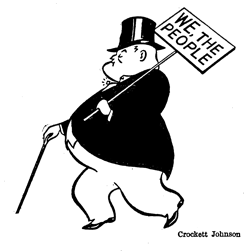MOE TKACIK ON HOW WE GOT HERE: For years, Wall Street has exhibited only contempt for anyone on the government payroll who did not work for the Fed. This attitude was abetted and enabled by a Republican leadership that did not trust its own party members on the Financial Services Committee. They saw this coming — when Long Term Capital Management almost exploded the markets as a direct result of the “counterparty risk”  that bound us to bail out AIG, when Enron touched off a wave of 30 or so separate multi-billion-dollar accounting restatements that killed Arthur Andersen and made laughingstocks of the entire accounting industry — but the fact-resistant, and fundamentally provincial, disdain of jerkoffs like George W. Bush and Tom DeLay — and Ratigan — kept them from doing anything, in a perverse decade-long pattern of willful neglect that systematically and repeatedly undermined every federal agency charged with regulating the financial system. MORE
that bound us to bail out AIG, when Enron touched off a wave of 30 or so separate multi-billion-dollar accounting restatements that killed Arthur Andersen and made laughingstocks of the entire accounting industry — but the fact-resistant, and fundamentally provincial, disdain of jerkoffs like George W. Bush and Tom DeLay — and Ratigan — kept them from doing anything, in a perverse decade-long pattern of willful neglect that systematically and repeatedly undermined every federal agency charged with regulating the financial system. MORE
PAUL KRUGMAN ON CITIBANK FAILOUT: A bailout was necessary — but this bailout is an outrage: a lousy deal for the taxpayers, no accountability for management, and just to make things perfect, quite possibly inadequate, so that Citi will be back for more. Amazing how much damage the lame ducks can do in the time remaining.
JAMES KWAK ON CITIBANK FAILOUT: The government (should have) had two goals for this bailout. First, since everyone assumes Citi is too big to fail, the bailout had to be big enough that it would settle the matter once and for all. Second, it had to define a standard set of terms that other banks could rely on and, more importantly, the market could rely on being there for other banks. This plan fails on both counts.
 The arithmetic on this deal doesn’t seem to work for me (feel free to help me out). Citi has over $2 trillion in assets and several hundred billions of dollars in off-balance sheet liabilities. $27 billion is a drop in the bucket. Friedman Billings Ramsey last week estimated that Citi needed $160 billion in new capital. (I’m not sure I agree with the exact number, but that’s the ballpark.) Yes, there is a guarantee on $306 billion in assets (which will not get triggered until that $27 billion is wiped out), but that leaves another $2 trillion in other assets, many of which are not looking particularly healthy. If I’m an investor, I’m thinking that Citi is going to have to come back again for more money.
The arithmetic on this deal doesn’t seem to work for me (feel free to help me out). Citi has over $2 trillion in assets and several hundred billions of dollars in off-balance sheet liabilities. $27 billion is a drop in the bucket. Friedman Billings Ramsey last week estimated that Citi needed $160 billion in new capital. (I’m not sure I agree with the exact number, but that’s the ballpark.) Yes, there is a guarantee on $306 billion in assets (which will not get triggered until that $27 billion is wiped out), but that leaves another $2 trillion in other assets, many of which are not looking particularly healthy. If I’m an investor, I’m thinking that Citi is going to have to come back again for more money.
In addition, the plan is arbitrary and cannot possibly set an expectation for future deals. In particular, by saying that the government will back some of Citi’s assets but not others, it doesn’t even establish a principle that can be followed in future bailouts. In effect, the message to the market was and has been: “We will protect some (unnamed) large banks from failing, but we won’t tell you how and we’ll decide at the last minute.)” As long as that’s the message, investors will continue to worry about all U.S. banks. MORE
